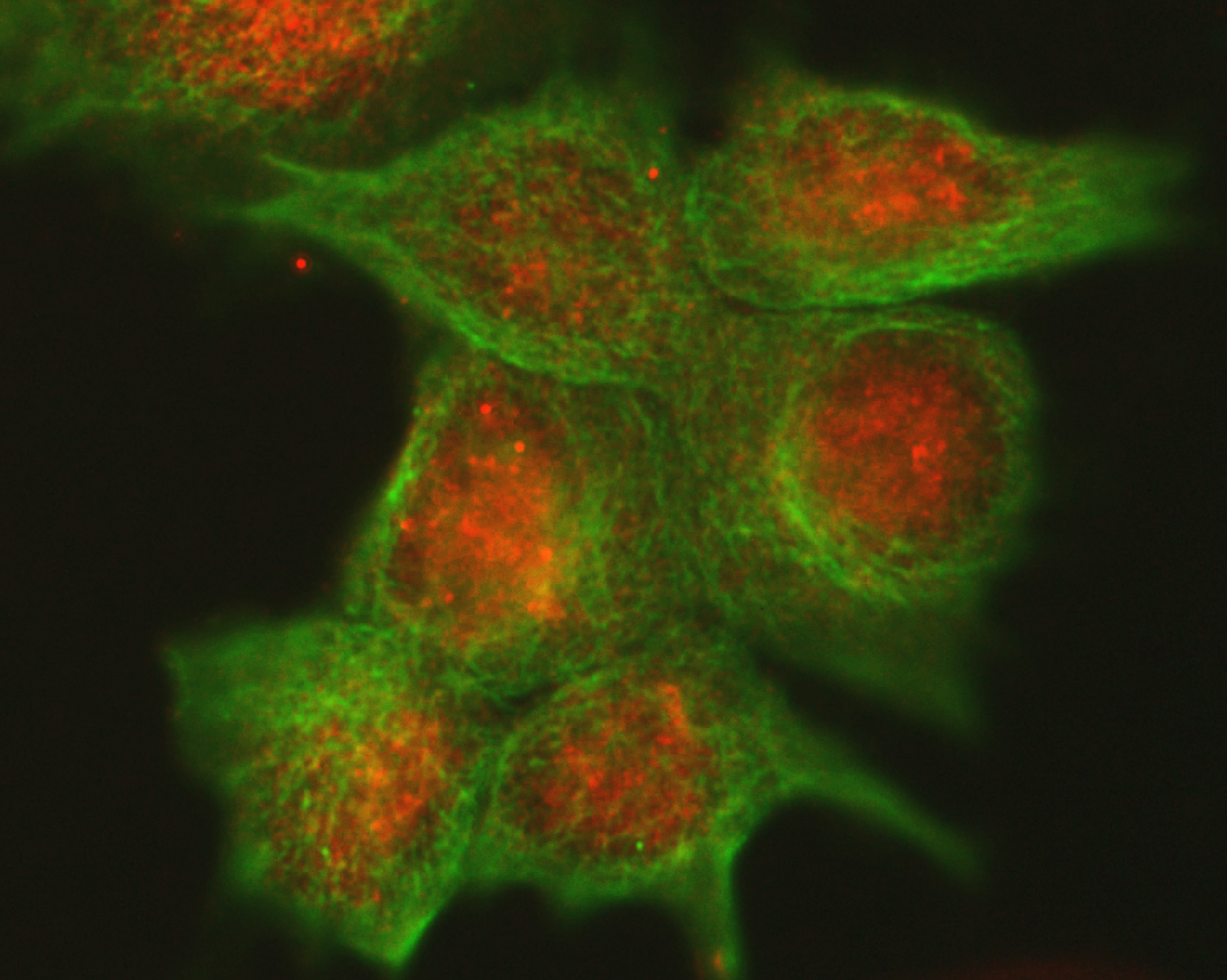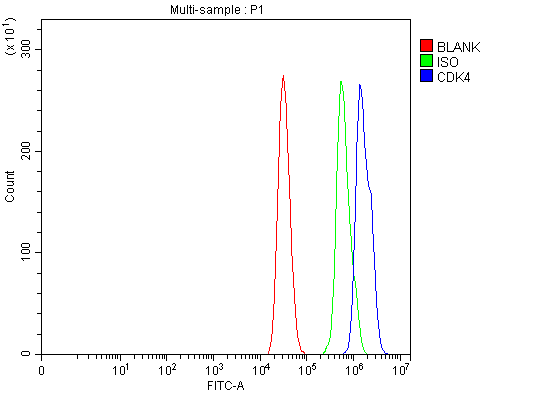| Western blot (WB): | 1:500-2000 |
| Immunocytochemistry/Immunofluorescence (ICC/IF): | 1:50-400 |
| Flow Cytometry (Fixed): | 1:50-200 |

Western blot analysis of anti-CDK4 antibody (BA0310-2). The sample well of each lane was loaded with 30 ug of sample under reducing conditions.
Lane 1: human Hela whole cell lysates,
Lane 2: human K562 whole cell lysates,
Lane 3: rat PC-12 whole cell lysates,
Lane 4: mouse NIH/3T3 whole cell lysates,
Lane 5: mouse RAW 264.7 whole cell lysates.
After electrophoresis, proteins were transferred to a membrane. Then the membrane was incubated with rabbit anti-CDK4 antigen affinity purified polyclonal antibody (BA0310-2) and probed with a goat anti-rabbit IgG-HRP secondary antibody (Catalog # BA1054). The signal is developed using ECL Plus Western Blotting Substrate (Catalog # AR1197). A specific band was detected for CDK4 at approximately 34 kDa. The expected band size for CDK4 is at 34 kDa.

ICC/IF analysis of CDK4 using anti-CDK4 antibody (BA0310-2) and anti-Tubulin alpha antibody (M03989-3).
CDK4 was detected in an immunocytochemical section of MCF-7 cells. Cy3-Conjugated Anti-rabbit IgG Secondary Antibody (Red) (Catalog # BA1032) and Fluoro488-conjugated Anti-mouse IgG Secondary Antibody (Green) (Catalog # BA1126) were used as secondary antibody.

Flow Cytometry analysis of MCF-7 cells using anti-CDK4 antibody (BA0310-2).
Overlay histogram showing MCF-7 cells stained with BA0310-2 (Blue line). To facilitate intracellular staining, cells were fixed with 4% paraformaldehyde and permeabilized with permeabilization buffer. The cells were blocked with 10% normal goat serum. And then incubated with rabbit anti-CDK4 Antibody (BA0310-2) at 1:100 dilution for 30 min at 20°C. Fluoro488 conjugated goat anti-rabbit IgG (BA1127) was used as secondary antibody at 1:100 dilution for 30 minutes at 20°C. Isotype control antibody (Green line) was rabbit IgG at 1:100 dilution used under the same conditions. Unlabelled sample without incubation with primary antibody and secondary antibody (Red line) was used as a blank control.

Western blot analysis of anti-CDK4 antibody (BA0310-2). The sample well of each lane was loaded with 30 ug of sample under reducing conditions.
Lane 1: human Hela whole cell lysates,
Lane 2: human K562 whole cell lysates,
Lane 3: rat PC-12 whole cell lysates,
Lane 4: mouse NIH/3T3 whole cell lysates,
Lane 5: mouse RAW 264.7 whole cell lysates.
After electrophoresis, proteins were transferred to a membrane. Then the membrane was incubated with rabbit anti-CDK4 antigen affinity purified polyclonal antibody (BA0310-2) and probed with a goat anti-rabbit IgG-HRP secondary antibody (Catalog # BA1054). The signal is developed using ECL Plus Western Blotting Substrate (Catalog # AR1197). A specific band was detected for CDK4 at approximately 34 kDa. The expected band size for CDK4 is at 34 kDa.

ICC/IF analysis of CDK4 using anti-CDK4 antibody (BA0310-2) and anti-Tubulin alpha antibody (M03989-3).
CDK4 was detected in an immunocytochemical section of MCF-7 cells. Cy3-Conjugated Anti-rabbit IgG Secondary Antibody (Red) (Catalog # BA1032) and Fluoro488-conjugated Anti-mouse IgG Secondary Antibody (Green) (Catalog # BA1126) were used as secondary antibody.

Flow Cytometry analysis of MCF-7 cells using anti-CDK4 antibody (BA0310-2).
Overlay histogram showing MCF-7 cells stained with BA0310-2 (Blue line). To facilitate intracellular staining, cells were fixed with 4% paraformaldehyde and permeabilized with permeabilization buffer. The cells were blocked with 10% normal goat serum. And then incubated with rabbit anti-CDK4 Antibody (BA0310-2) at 1:100 dilution for 30 min at 20°C. Fluoro488 conjugated goat anti-rabbit IgG (BA1127) was used as secondary antibody at 1:100 dilution for 30 minutes at 20°C. Isotype control antibody (Green line) was rabbit IgG at 1:100 dilution used under the same conditions. Unlabelled sample without incubation with primary antibody and secondary antibody (Red line) was used as a blank control.


